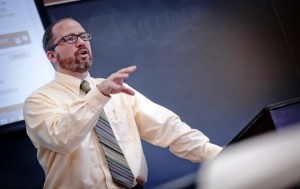Teaching introductory courses isn’t something Brett Hendrickson tries to avoid. While the material may be basic, it has the potential to help shape the worldviews of his students, many of whom are learning about the world’s religious diversity for the first time.

Professor Brett Hendrickson teaches Contemporary Religious Issues in Pardee Hall
“I really enjoy teaching introductory classes about religion. Introductions open up so many new and exciting lines of inquiry for undergraduates,” says Hendrickson, assistant professor of religious studies. “Lafayette students are go-getters, and they are eager to make new discoveries about themselves and about the world we live in. It is my pleasure to introduce many of them to the richness and diversity of religions and let that knowledge be part of their maturation.”
Teaching at a small, undergraduate-only school like Lafayette allows Hendrickson to teach the same students in several courses. They are not just faces in the crowd—Hendrickson can follow their progress and participate in their process of finding out who they are and who they want to be as adults.
Working with people who are in the midst of big transitions in life and facing challenges—hallmarks of any college experience—is a skill Hendrickson honed during his time as a Presbyterian pastor. While he no longer serves a local congregation, Hendrickson still teaches regularly in local churches and for church judicatories. He also attends services regularly with his wife, the Rev. Alex Hendrickson, director of religious and spiritual life and College chaplain.
His research interests result from the few years he spent living as a young adult volunteer for the Presbyterian Church in Buenos Aires. There, he learned Spanish, worked on community development projects, and became enthralled by Latin America’s religious history and the character of the region. He put his Spanish skills to good use after his ordination by ministering to Spanish-speaking Mexicans and Mexican Americans in Arizona.
Curanderismo
One of Hendrickson’s primary research interests is curanderismo, a short-hand term for Latin American folk and religious healing. It was the subject of his doctoral dissertation at Arizona State University, Tempe, as well as his forthcoming book currently under review, Curanderismo in the United States: Mexican American Healing in the Borderlands and Beyond.
Always interested in the daily devotions of Latin Americans, Hendrickson began exploring how those devotions are connected to physical, emotional, and spiritual health. Saint veneration, prayer cycles, and pilgrimages all revolve around participants’ supplications for healing and restoration, he says.
Hendrickson discusses curanderismo in his Religious Healing and Health and Latino/a Religions courses. Blending his research interests with his courses fits perfectly with the College’s goal to increase diversity education in the curriculum, an initiative funded by a grant from the Teagle Foundation. Diversity in this sense refers not just to identity-based diversity like race and gender, but also to issues of class, privilege, and access. Hendrickson makes it a priority to incorporate course materials and assignments that challenge students to think critically about human diversity and their own place within society.
“While learning about other people is good in and of itself, it is also my goal that students learn more about themselves by studying others,” he says. “In today’s economy, students and parents are often keen to know how a particular college course will impact their ability to flourish in the workplace. It is my goal that the core liberal arts values of Lafayette set our graduates apart not only as talented and well-trained future workers, but as responsible, multifaceted, creative, analytical individuals who add to our world in a wide variety of ways.”
Other publications
In June, the Journal of the American Academy of Religion will publish Hendrickson’s article “New Contexts for Curanderismo: Recasting Mexican American Folk Healing within Metaphysical Religion.”
He is submitting an essay to the journal Spiritus on the reclamation of pre-Columbian spirituality in some Mexican and Mexican American communities. In it, he examines the claims that modern people can reclaim and practice indigenous Mesoamerican religions and argues that these reclamation movements divulge more about the complexity of Christian identity regarding colonialism and racial prejudice than about indigenous religions.
He also is working on a journal article about the spread of Mexican American folk and religious healing to the Internet, including how curanderismo is expressed online and how authority among healers is established in online contexts.
Hendrickson also will have a chapter in the collection Between the Pew and the Picket Line: Christianity and the Working Classes in Industrial America. His chapter will focus on how Catholic social policy contributed to Christian critiques of the bracero guest worker program and the eventual formation of the United Farm Workers.

2 Comments
This is great news! Will report to the folks in Guadalupe.
Let us know when you come back to Arizona for a visit.
Brett, I am proud of you. Grandma
Comments are closed.